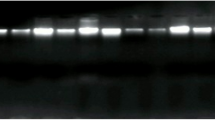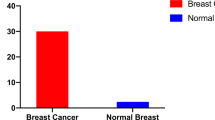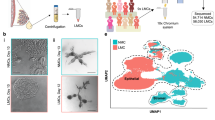Abstract
MANY investigators have tried to correlate the genesis of human breast cancer with the presence of a virus. In spite of many electron microscopical studies1,2, however, no convincing evidence of an association of human breast cancer with virus has been demonstrated. Last year, Moore and his colleagues3 reported that they had found particles with the same morphological characteristics as those that cause breast cancer in mice (B particles), in the milk of 5% of the American women with no history of the disease in their families; in 60% of the Americans with a history of the disease in their families ; and in 39% of Parsi women. Sarkar and Moore4 distinguish the particles in human milk with a size and shape similar to the B particles into three classes: MS-1 identical to the B particles ; MS-2 particles with the surface projections different from B, and MS-3 smooth particles. These results encouraged us to examine milk samples from Dutch women for the presence of virus-like particles.
This is a preview of subscription content, access via your institution
Access options
Subscribe to this journal
Receive 51 print issues and online access
$199.00 per year
only $3.90 per issue
Buy this article
- Purchase on Springer Link
- Instant access to full article PDF
Prices may be subject to local taxes which are calculated during checkout
Similar content being viewed by others

References
Dmochowski, L., Seman, G., and Stephen, H., Cancer, 24, 1241 (1969).
Feller, W. F., and Chopra, H. C., Cancer, 24, 1250 (1969).
Moore, D. H., Charney, J., Kramarsky, B., Lasfargues, E. Y., Sarkar, N. H., Brennan, M. J., Burrows, J. H., Sirsat, S. M., Paymaster, J. C., and Vaidya, A. B., Nature, 229, 611 (1971).
Sarkar, N. H., and Moore, D. H., Nature, 236, 103 (1972).
Calafat, J., and Hageman, Ph. C., J. Gen. Virol., 14, 103 (1972).
Moore, D. H., Sarkar, N. H., Kelly, C. E., Pillsbury, N., and Charney, J., Texas Rep. Biol. Med., 27, 1027 (1969).
Chenaille, P., Levy, J. P., Tavitian, A., and Boiron, M., Nature, 213, 107 (1967).
Anderson, R., The Wistar Institute Symposium Monograph No. 4 (edit. by Defendi, V.), 113 (The Wistar Institute Press, Philadelphia, 1965).
de Harven, E., The Wistar Institute Symposium Monograph No. 4 (edit. by Defendi, V.), 147 (The Wistar Institute Press, Philadelphia, 1965).
Jensen, E. M., and Schidlowsky, G., J. Nat. Cancer Inst., 33, 1029 (1964).
Sarkar, N. H., and Moore, D. H., J. Nat. Cancer Inst., 48, 1051 (1972).
Schlom, J., Spiegelman, S., and Moore, D., Nature, 231, 97 (1971).
Author information
Authors and Affiliations
Rights and permissions
About this article
Cite this article
CALAFAT, J., HAGEMAN, P. Remarks on Virus-like Particles in Human Breast Cancer. Nature 242, 260–262 (1973). https://doi.org/10.1038/242260a0
Received:
Issue Date:
DOI: https://doi.org/10.1038/242260a0
This article is cited by
-
Biochemical and electron microscopical evidence for the presence of oncorna viruses in spleen tissue from two patients with haematological malignancies
Molecular Biology Reports (1976)
-
Attempts to Detect RNA Tumour Virus in Human Milk
Nature New Biology (1973)
Comments
By submitting a comment you agree to abide by our Terms and Community Guidelines. If you find something abusive or that does not comply with our terms or guidelines please flag it as inappropriate.


